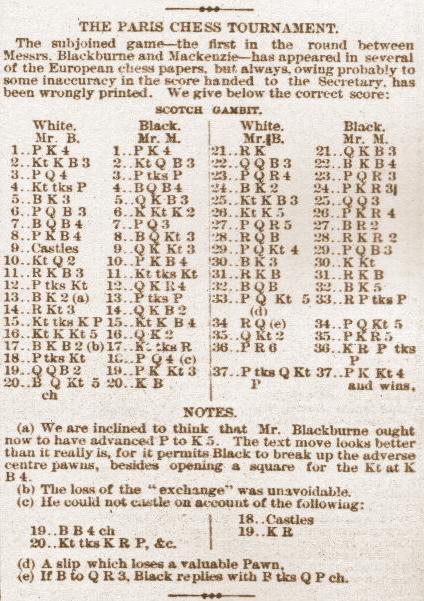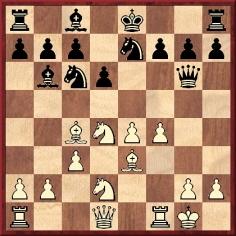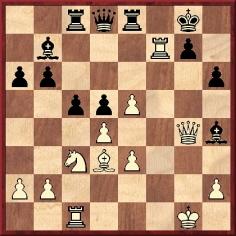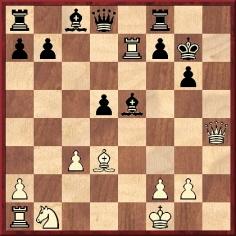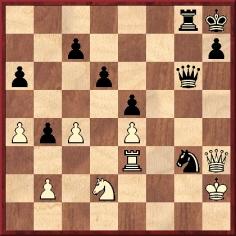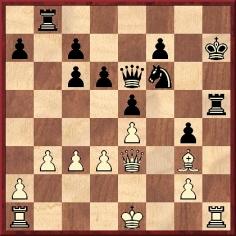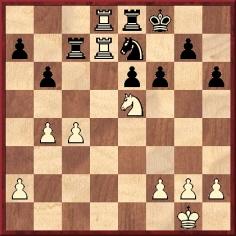Chess
Notes
|
| First column | << previous | Archives [46] | next >> | Current column |
5543. Pasadena, 1932
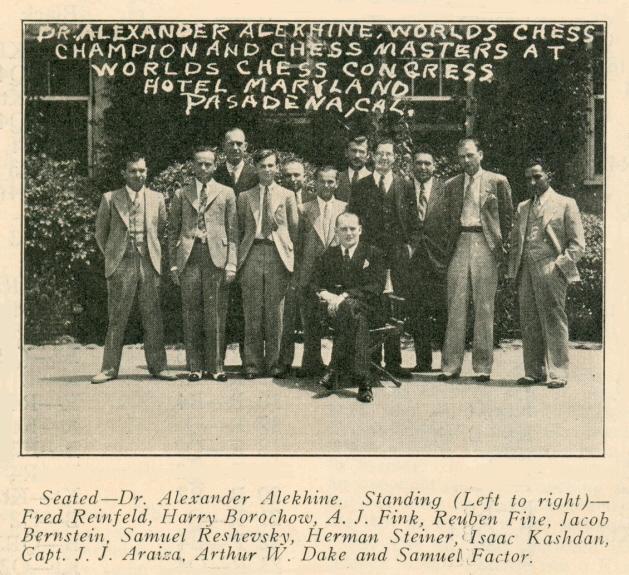
This group photograph was published on page 116 of the July-August 1932 American Chess Bulletin. Does any reader have a better copy?
5544. Engels v Kieninger
Pierre Bourget (Quebec, Canada) asks who won this game: 1 e4 e5 2 Nf3 Nc6 3 Bb5 a6 4 Ba4 Nf6 5 O-O Nxe4 6 d4 b5 7 Bb3 d5 8 dxe5 Be6 9 c3 Be7 10 Nd4 Nxe5 11 f3 Nc5 12 Bc2 Bd7 13 b4 Na4 14 Re1 Nc4 15 Qe2 Kf8 16 Nd2 Bf6 17 Nxc4 bxc4 18 Bxa4 Bxa4 19 Be3 Qd7 20 Qd2 h6 21 Bf4 Kg8 22 Be5 Bd8 23 Re2 Kh7 24 Rae1 Rf8 25 Qc1 Qc8 26 Qb1+ f5
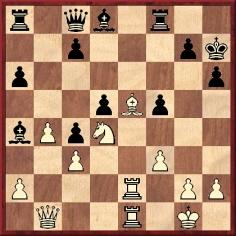
27 Bxg7 Kxg7 28 Ne6+ Kf7 29 Qxf5+.
Our correspondent took the game from the ChessBase Megabase, which states that it was played at Krefeld, 1938 and that Engels was the victor, against Kieninger. However, Mr Bourget points out that according to the crosstable of that tournament Kieninger won their individual encounter.
The game was indeed won by Engels, but at the Wuppertal-Barmen tournament, held in May 1938. Kieninger, who resigned at move 29, annotated it on pages 167-168 of Deutsche Schachblätter, 1 June 1938.
5545. Counter-attack (C.N.s 5090 & 5148)
The dictum ‘counter-attack is the best form of defence’ was traced back to J.A. de Rivière in 1860 or 1861, but now we note the following on page 30 of The Art of Chess-Play by George Walker (London, 1846):
‘The strongest defence is counter-attack.’
We have had no opportunity yet to ascertain whether earlier editions of Walker’s books contained the same, or a similar, remark. As ever, readers’ assistance will be appreciated.
Addition:
The sentence also appeared on page 30 of the book’s immediate predecessor, the third edition of A New Treatise on Chess (London, 1841).
Moreover, in his chess column on page 3 of Bell’s Life in London, 10 May 1835, Walker wrote:
‘White, like Hannibal, carries the attack into his enemy’s country, and furnishes a strong example of what we so much and constantly endeavour to impress on the minds of all chess students: “The strongest defence is counter-attack”.’
The newspaper gave the dictum in capital letters.
5546. Knight tours
Wanted: examples of the knight tour in actual play. It will, though, be hard to match the re-entrant specimen (Vilela v Estévez, Holguín, 1984) which a correspondent, Ronald Pearce, presented in C.N. 1446 (see page 20 of Chess Explorations):
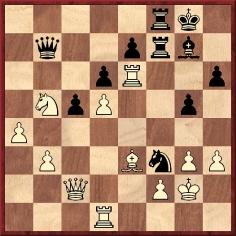
Play continued 28…Qxd5 29 Rxd5 Ne1+ 30 Kf1 Nxc2 31 Rd2 Nb4 32 Kg2 Nc6 33 Re4 Ne5 34 Rd5 Nf3, and the game was drawn at move 41.
5547. Hans Frank
Martin Weissenberg (Savyon, Israel) quotes an extract from an article by Hans Kmoch about Nimzowitsch which mentions Hans Frank:
‘My last meeting with Nimzowitsch was also the longest. It took place in 1934, when we were both following the second Alekhine-Bogoljubow world championship match as reporters. The games of the match were scheduled to be played in many parts of Nazi Germany – unfriendly territory for a Jew and not particularly safe for a Gentile either, in view of the tensions immediately preceding Hitler’s bloody purge of his political enemies, among them Ernst Röhm.
Nimzowitsch considered himself protected by three consulates: the Latvian because of his birthplace, the Danish because of his residence, and the Dutch because some of his reports were going to a newspaper in Holland. He boasted of this protection even to Reichsminister Hans Frank, who at that time was in charge of the “protection” of art and later became the governor of Nazi- occupied Poland. Frank followed a few games of the match and sometimes chatted with the masters and reporters, including Nimzowitsch. He even invited the whole chess troupe to his villa for lunch. The Jews Mieses and Nimzowitsch were included in the invitation, but only Nimzowitsch showed up. At the luncheon he demonstrated his usual persecution mania by complaining first about a dirty plate and then about a dirty knife. The Reichsminister, seated directly opposite him, pretended not to hear.
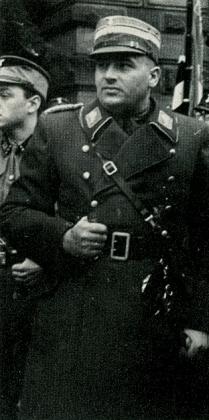
Hans Frank
In Kissingen, where some of the match games were played, I was a guest in the same hotel at which I had stayed during the tournament in 1928. Overcrowded then, it was empty in 1934. At dinnertime, when the restaurant should have been crowded, there were only four people in the room: my wife and I, and, at another table, Frank and an elderly man who I later learned was the composer Richard Strauss. The sinister emptiness of that dining room, which the hotel manager attributed to “bad economic conditions”, should have been a forewarning, but the Nazi leaders understood nothing. Frank himself failed to understand what was going on under his governorship in Poland. He became known as “the butcher of Poland”, and for his war crimes he was hanged in Nuremberg.’
If any reader has Nimzowitsch’s reports on the 1934 world championship match we should be grateful to know whether they contain points of particular interest.
5548. Nimzowitsch and exercise

Aron Nimzowitsch
On pages 128-129 of The World’s Great Chess Games by Reuben Fine (New York, 1951) the following appeared regarding Nimzowitsch:
‘Many other eccentricities are reported of him. At one time a doctor ordered him to do calisthenics; he began to do them in the tournament room. During a particularly difficult situation once, he went to a corner and stood on his head.
Were it not for these unfortunate aberrations, Nimzowitsch might well have become world champion.’
And from page 66 of Fine’s The Psychology of the Chess Player (New York, 1967):
‘Towards the end of his life, (1929-35), the émigré Russian master Aron Nimzowitsch was advised by his physician to take more exercise. He thereupon proceeded to act on this advice by performing calisthenics during actual tournament play. When it was not his move, he would go off to his corner and do deep knee bends or the like. Several times he astonished spectators by standing on his head. In spite of these aberrations, Nimzowitsch scored his greatest successes around this period.’
Whether any corroboration exists for these claims that Nimzowitsch (‘once’ or ‘several times’) stood on his head we do not know, but when George Botterill mentioned the subject on page 461 of the December 1974 BCM he described Fine as ‘scurrilous’. We can add that the following was published on page 68 of the December 1946 CHESS, in an article by M.G. Sturm:
‘Another good method is to perform physical exercises on the floor. ... If anyone tries to stop you, quote Nimzowitsch, who attributed his success, at some tournament or other, to such a course of physical exercises.’
A further question is whether the story has any connection with the claim that Nimzowitsch ‘once’ broke his leg during a game of chess. This letter from Kester Svendsen was on page 101 of CHESS, January 1948:
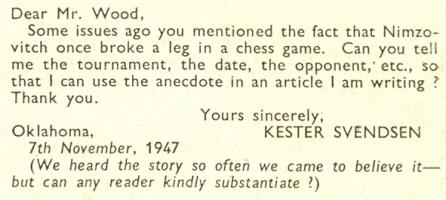
5549. Capablanca dressed for tennis (C.N. 4114)
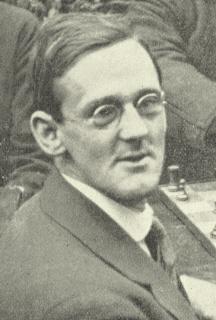
Frederick Dewhurst Yates
C.N. 4114 asked about the earliest sighting of the well-known story about Capablanca turning up in his tennis gear to resume a game of chess against Yates at Hastings, and we offered the following ‘once’ version by G. Koltanowski on page 180 of CHESS, 14 January 1936:
‘Capablanca once turned up to play off an adjourned game against Yates, dressed in white flannels and with a tennis racquet in his hand. Didn’t we chuckle when, four hours later, with the darkness of night outside the congress room, he was still playing – chess, not tennis.’
We added that Koltanowski wrote similarly on page 80 of With the Chess Masters (San Francisco, 1972), whereas on page 24 of Chessnicdotes II (Coraopolis, 1981) he stated that the episode had occurred ‘in the 1929 tournament at Hastings’ in a game between Capablanca and Vera Menchik.
Now an earlier (and, again, different) version by Koltanowski can be presented, from page 122 of the 1 December 1932 issue of his magazine Chess World:
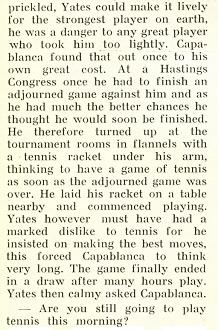
His account in CHESS spoke of ‘the darkness of night’, but now there is a reference to playing tennis ‘this morning’. More substantively, Capablanca and Yates had only one draw in any Hastings tournament, on 4 January 1930. Koltanowski was there, playing in the Premier Reserves event, but since the Cuban’s game against Yates was not adjourned (it lasted only 26 moves), the confusion continues.
5550. Thousand Islands, 1897
A photograph from page 148 of the American Chess Magazine, August 1897:

5551. Lupi and Alekhine (C.N. 4388)
The Portuguese champion Francisco Lupi gave some further observations about Alekhine on pages 204-207 of CHESS, April 1947:
‘With all respect to Botvinnik, I am not altogether convinced that the great master and Soviet champion would have won his match against Alekhine.
I knew Alekhine well during his last years. Throughout many a journey in Spain together, en route to participate in tournaments, I have come to know his every gesture. I have seen him attired superbly and I have seen him, not so much later, looking like a tramp. It has struck me how both in his play and in himself, how extraordinarily his style revealed itself in a capacity to improvize – and a capacity to recuperate. ...
It is true that, when he received here in Lisbon the news of the British Chess Federation’s negotiations for his match against Botvinnik, the great man was at his lowest ebb. But a few days afterwards, I watched him playing so beautifully, so ingeniously in friendly conflict with the well-known English problemist G.F. Anderson – no second-rate player either – that I felt his powers of recuperation were unimpaired.
It has frequently been said that, after his last match against Euwe, Alekhine had never recaptured the fire of his San Remo days. I should answer this by saying, simply, that in his later years he inclined more towards soundness and simplicity.’
On page 205 Lupi discussed Alekhine’s game against Paul Schmidt in the Warsaw-Cracow tournament on 10 October 1941 (game 2311 in the Skinner/Verhoeven book on Alekhine). Before presenting Lupi’s account we reproduce the relevant part of the game from page 171 of the November 1941 Deutsche Schachzeitung (notes by Blümich) and page 173 of the 1 November 1941 issue of Deutsche Schachblätter (annotations by Alekhine).
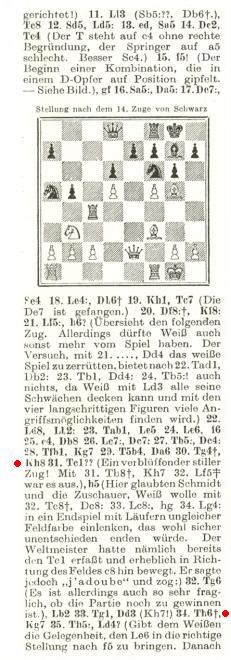
Deutsche Schachzeitung

Deutsche Schachblätter
Our diagram shows the position before Alekhine played 31 Rc1 h5 32 Rg6 (instead of 31 Rb8+ Qc8 32 Rxc8+ (or 32 Bxc8) and 33 Bf5 mate):
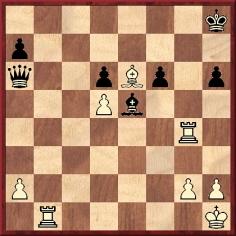
In CHESS Lupi wrote:
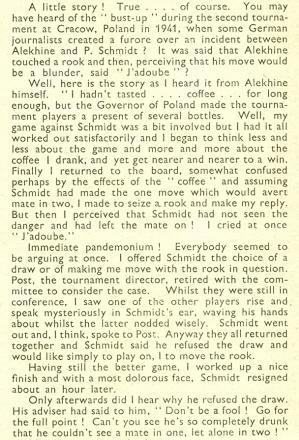
To the small number of photographs of Lupi which are available, we add one from opposite page 145 of La vida de Arturito Pomar by Juan M. Fuentes and Julio Ganzo (Madrid, 1946):
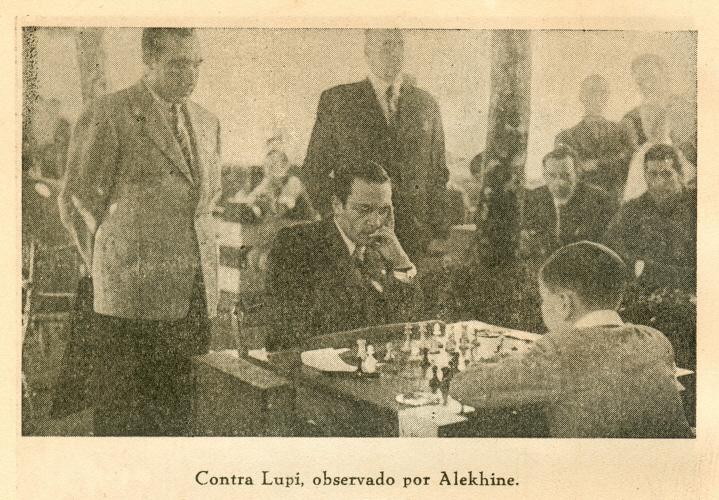
5552. Nimzowitsch and exercise (C.N. 5548)
Dan Scoones (Port Coquitlam, BC, Canada) notes that
page 24 of Nimzowitsch’s booklet Kak ya stal
grosmeysterom (Leningrad, 1929) recommended the
practice of gymnastics with ‘Müller’s system’.

Our correspondent identifies the book in question as Mein System 15 Minuten täglicher Arbeit für die Gesundheit by J.P. Müller, published at the beginning of the twentieth century.
5553. New Fischer book
Yakov Zusmanovich (Pleasanton, CA, USA) draws attention to the first monograph on Fischer to be published since the master’s death: Vybrané Partie Roberta Fischera by V. Babula, Z. Hráček, R. Biolek, D. Kaňovský and P. Šimáček.
5554. Crosstable wanted
Graeme Cree (Austin, TX, USA) is seeking the crosstable of the 35th USSR Championship (Kharkov, 1967). There were 126 participants (Swiss system), and the tournament was won by Polugayevsky and Tal.
5555. Who?

5556. Leit-motif
C.N. 438 (see page 113 of Chess Explorations) quoted Harry Golombek on page 362 of the December 1968 BCM, in a report on that year’s Olympiad:
‘It is an odd fact that most big chess events seem to have some main theme running through the best games, rather like the leit-motif of a Wagnerian opera. The theme at Lugano was the isolation of the black queen’s pawn and play on the white squares in front of it.’
Examples of tournaments with a theme are still being sought.
5557. Nimzowitsch’s dictum
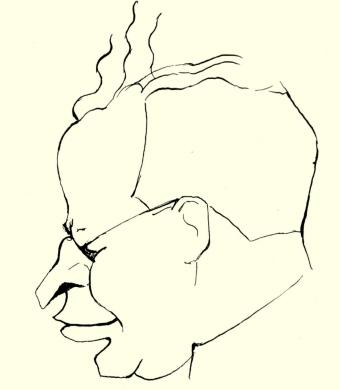
Aron Nimzowitsch (Schweizerische
Schachzeitung, May-June
1931, page 67)
A fresh addition to our feature article on ‘The Most Famous Chess Quotations’ is Nimzowitsch’s dictum ‘First restrain, next blockade, lastly destroy’. It is certainly famous, yet we are struck by how seldom it is to be found on the Internet. Moreover, not a single webpage consulted by us gives the source (My System), and we found no instance on-line of the original German (‘Zuerst hemmen, dann blockieren und schließlich vernichten’).
Below, to provide the context, is the full passage as
it appeared in the first German and English editions
(Berlin, 1925, page 246 and London, 1929, page 181):
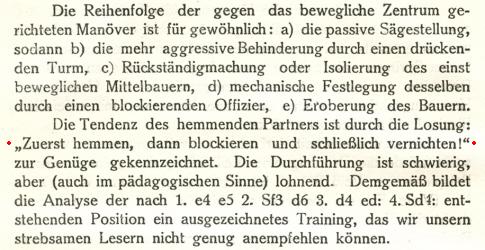
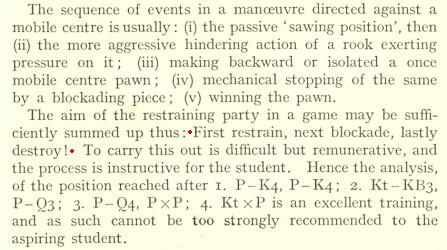
It was in the section entitled ‘Doppelbauer und Hemmung’/‘The Doubled Pawn and Restraint’. Page numbers vary, but in the later editions of My System in our collection the reference is page 133, 151, 207 or 217. The last of these relates to the translation published by Quality Chess, Göteborg in 2007, which had a slightly different wording: ‘First restrain, then blockade and finally destroy.’
5558. Blackburne v Mackenzie
Joost van Winsen (Silvolde, the Netherlands) writes:
‘Immediately after returning from Europe to New York G.H. Mackenzie published the following item in the Turf, Field and Farm (18 October 1878), stating that a game of his against Blackburne had been misprinted in a number of publications:
The game can be found in, for instance, the Illustrated London News of 27 July 1878, the Westminster Papers of August 1878 (pages 83-84) and the Paris, 1878 tournament book (pages 61-63), all with, at move ten, ...
... a different move sequence: 10...f6 11 Rf3 Nxd4 12 cxd4 f5.
After giving Black’s tenth move as 10...f6, William N. Potter wrote in the Westminster Papers:
“If the score be correct, this is an outrageous b[l]under. And were it otherwise, I cannot see any merit in the move.”’
Below is the complete game-score as presented by Mackenzie (with no opportunity for White to win outright by 11 f5):
Joseph Henry Blackburne – George Henry MackenzieParis, 1 July 1878
Scotch Game
1 e4 e5 2 Nf3 Nc6 3 d4 exd4 4 Nxd4 Bc5 5 Be3 Qf6 6 c3 Nge7 7 Bc4 d6 8 f4 Bb6 9 O-O Qg6 10 Nd2 f5 11 Rf3 Nxd4 12 cxd4 Qh5 13 Be2 fxe4 14 Rg3 Qf7 15 Nxe4 Nf5 16 Ng5 Qe7 17 Bf2 Nxg3 18 hxg3 d5 19 Qc2 g6 20 Bb5+ Kf8 21 Re1 Qf6 22 Qc3 Bf5 23 a4 a6 24 Be2 h6 25 Nf3 Qd6 26 Ne5 h5 27 a5 Ba7 28 Rc1 Rh7 29 b4 c6 30 Be3 Kg8 31 Rf1 Rf8 32 Bc1 Be4 33 b5 axb5 34 Rd1 b4 35 Qb2 h4 36 a6 hxg3 37 axb7 g5 and wins.
5559. Chessy words
It is some time since an addition was made to our Chessy Words feature article, but Mark McCullagh (Belfast, Northern Ireland) now supplies a citation for ‘chessophile’:
‘[Ray] Kennedy himself has been a chessophile since the age of nine, and still spends an occasional evening at an all-night chess parlor.’
Source: ‘A
letter
from the publisher’ by Ralph P. Davidson, Time,
31 July 1972, page 2.
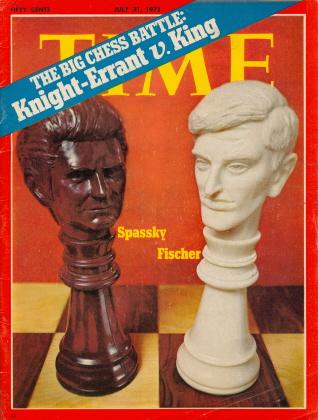
Kennedy was the author of the cover article on pages 32-37 of that issue – a catchpenny thing ‘The Battle of the Brains’ which was mainly about Spassky and Fischer but also leapt gleefully on whatever might serve to ridicule such great players of the past as Morphy, Steinitz and Alekhine. For example (from page 35):
‘Morphy was given to such eccentricities as arranging women’s shoes in a semicircle in his room and prancing around his veranda reciting in French that “the little king will go away unabashed” [sic – an apparent miscopying of ‘all abashed’].’
In short, yet another ‘Fun’ writer for whom Reuben Fine’s The Psychology of the Chess Player was a godsend.
5560. Philidor’s famous remark
To our article on The Most Famous Chess Quotations we plan to add shortly Philidor’s remark about pawns being the soul of the game. For example, to cite page xii of his book L’analyse des échecs (London, 1752 edition): ‘... les Pions. Ils ſont l’ame des Echecs.’ (The modern spelling of ‘ſont l’ame’ is ‘sont l’âme’.)
If a reader has access to a range of editions of Philidor’s book (in French and English) we shall be grateful for information on how the wording of this observation may have varied over the years.
5561. Hypermodern (C.N. 4140)
C.N. 4140 asked when the term ‘hypermodern chess’ was first used and mentioned that an article entitled ‘Das hypermoderne Schach’ appeared in Am Baum der Schacherkenntnis by S. Tartakower (Berlin, 1921). As regards the word ‘hypermodern’ on its own, we now offer passages from pages 253 and 265 of the August-September 1913 Wiener Schachzeitung (respectively the magazine’s introduction to an article by Alapin and the relevant part of that article):


5562. Leit-motif (C.N. 5556)
From Per Skjoldager (Fredericia, Denmark):
‘In the Nordic tournament in Copenhagen, 1916 four of the seven games of the Swedish player S.O. Svensson had the leit-motif Qg5, as reported in Nordiska Schackförbundets Sjunde Kongress (the tournament book which appeared as the 8-9/1916 issue of Tidskrift för Schack).
In his game against P. Johner in round one (page 135) this position arose:
Instead of 18...Kxf7, which led to a quick loss, Svensson could have saved himself with 18...Qg5.
In Svensson’s game against O. Löwenborg (round three) the note to White’s 20th move (page 142) recalled his missed opportunity against Johner and added:
“But every cloud has a silver lining. He solemnly promised that he would never again refrain from Qg5. Thus ...
20 Qg5!”
In his game against G. Nyholm (round four) this position was reached after 35 Rxe3 (page 144):
Missing 35...Nxe4, Svensson played 35...Qg5, which was given two question marks, as was White’s reply 36 Nf1 (instead of simply 36 Qxg3). After 36...Nxe4 White resigned.
And finally, in Svensson’s game against E. Jacobsen in round five (page 148) the following position occurred:
Svensson played 23 O-O-O, planning 24 Qg5. After 23...c5?? the annotation read:
“Mr Jacobsen was, shortly before the game, reminded to be on guard against Mr Svensson’s favourite move Qg5, but in the heat of the battle he forgot the well-meant advice. White now wins a piece.”
Later, for the banquet, a special song was composed which mentioned Svensson and Qg5 (pages 130-131).’
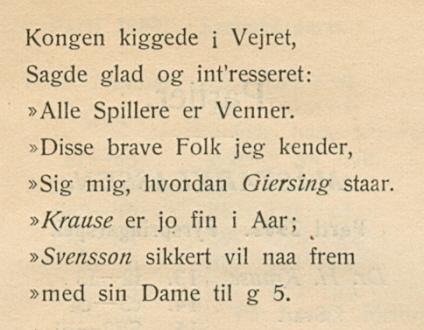
Below is the tournament book’s frontispiece:

Copenhagen, 1916
5563. Who? (C.N. 5555)
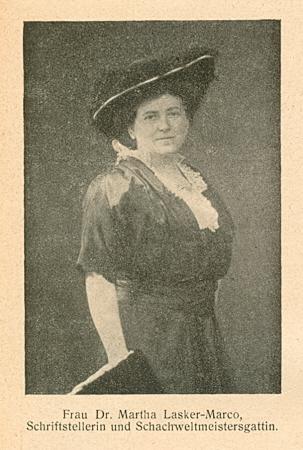
Source: Page 502 of Die Hypermoderne Schachpartie by S. Tartakower (Vienna, 1924).
5564. Zukertort odds game
‘Perhaps the most extraordinary finish in the history of the game’, wrote Fred Reinfeld on page 18 of British Chess Masters Past and Present (London, 1947) about this contest, played at the odds of queen’s knight:
1 f4 e6 2 Nf3 Nf6 3 b3 d5 4 Bb2 c5 5 e3 Nc6 6 a3 a6 7 Bd3 Bd6 8 Qe2 O-O 9 g4 Nxg4 10 Qg2 Nf6 11 h4 h6 12 h5 Kh8 13 O-O-O Ne8 14 Rdg1 Rg8
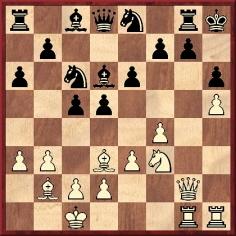
15 Bh7 f6 16 Bxg8 Kxg8 17 Qg6 Kh8 18 Ng5 hxg5 19 fxg5 Ne7 20 gxf6 Nxg6 21 hxg6+ Kg8 22 Rh8+ Kxh8 23 f7 Resigns.
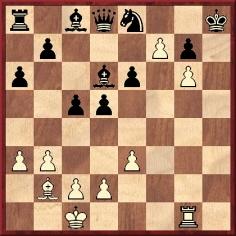
‘Unfortunately, the place and the date of this encounter are not available’, added Reinfeld, whose only information was that Zukertort had defeated an amateur. A couple of years later, however, some details were added on page 218 of Chernev and Reinfeld’s The Fireside Book of Chess: Black’s name was given as Epoureano and the occasion was ‘Berlin, 1874’. The score appeared in the chapter on odds games, and the co-authors commented:
‘To Zukertort goes the honor of producing the finest finish in this type of contest.’
Similar sentiments had been expressed by Francis J. Wellmuth on page 5 of The Golden Treasury of Chess (New York, 1943):
‘This is the finest odds-game ever played.’
Wellmuth did not name Black, and as the occasion he put ‘London, ca 1875’.
In fact, the game had already appeared on page 68 of the April 1874 issue of the City of London Chess Magazine, with Black identified as Count de Kostaki Epoureano:
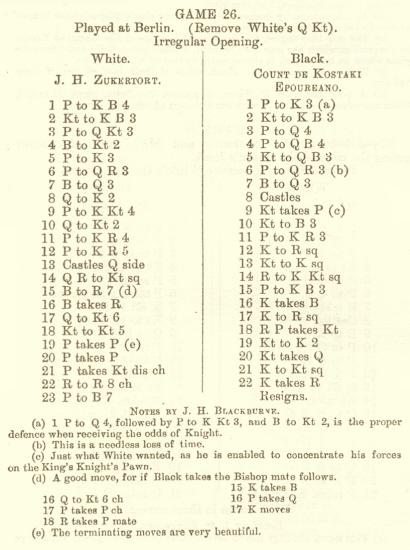
Zukertort was a contributor to the periodical. The game, placed in Berlin, was undated, but when Blackburne’s notes were reproduced on page 212 of Johannes Zukertort Artist of the Chessboard by Jimmy Adams (Yorklyn, 1989) the occasion was specified as ‘Berlin, May 1872’.
Any further details regarding the circumstances of the game will be appreciated.
5565. Rooks of opposite colours
Harrie Grondijs (Rijswijk, the Netherlands) draws attention to this report by Steinitz on the London, 1883 tournament in the Turf, Field and Farm of 18 May 1883:
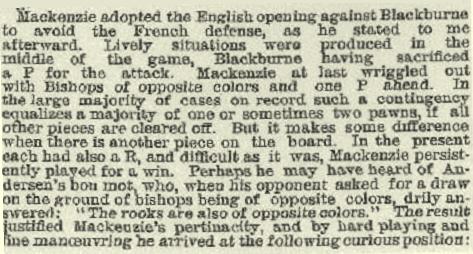
We add that in his annotations (The Field, 4 September 1875, page 277) to Burn v MacDonnell, Glasgow, 1875 Steinitz commented as follows after White’s 43rd move:
‘Anderssen once dryly observed to an opponent who offered him a draw in a position somewhat similar to this: “True enough, the bishops are of adverse colours, but so are the kings and the rooks.”’
See page 116 of Amos Burn A Chess Biography by Richard Forster (Jefferson, 2004).
5566. Who?
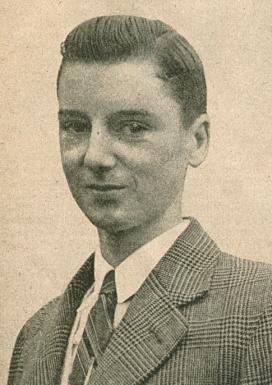
5567. Woodpusher (C.N. 5378)
Dan Scoones (Port Coquitlam, BC, Canada) writes:
‘C.N. 5378 reminded me of the short story “A Strange Simultaneous Display” by Marc Benoit on pages 203-208 of The Best In Chess by I.A. Horowitz and Jack Straley Battell (New York, 1965). The protagonist, Holz Schieber, fresh from a match victory over the Russian player Tolkai Derevyachkou, is induced to give a simultaneous exhibition against two local players in the small Quebec town of Poussebois. Schieber’s opponents conspire to copy the master’s moves so that, in effect, he is playing against himself. To subvert the plot he deliberately makes an illegal move on the first board. The second opponent dutifully follows suit, and Schieber immediately demands that the second opponent correct the illegal move. This allows him to send the two games down different paths, but it is all for nothing because he ends up losing both games. Of course, the names Holz Schieber, Tolkai Derevyachkou and Poussebois all translate (more or less) as “woodpusher”.’
The story had been published on pages 108-109 of the April 1954 Chess Review.
5568. Zukertort odds game (C.N. 5564)
Eduardo Bauzá Mercére (New York, NY, USA) suggests, on the basis of material available on the Internet, that Zukertort’s opponent was Manolache Kostaki Epureanu. He comments:
‘Variations found in the spelling of his name are Manolaki Costaki Epureanu and Manolaki Costaki Epureano, with his dates given as 1824-1880. Whether he was a Count I have not been able to determine, but his daughter, a famous pianist, was “Principesa” Elena Bibescu.’
5569. Fischer poem
Wayne D. Komer (Toronto, Canada) sends a 32-line poem ‘Master-passion’ by Roger Woddis which was published in the New Statesman of 7 July 1972, page 10. It concerned the world championship match in Iceland and was by no means flattering to the American challenger’s conduct or state of mind.
5570. Chess and boxing
A photograph of the boxing champion Manny Pacquiao playing chess is pointed out by Edward Zoerner (Redondo Beach, CA, USA).
Lennox Lewis was mentioned in our Chess Awards article. There is a well-known picture (it accompanied the Time article discussed in C.N. 5559) of Fischer torse nu confronting a punchbag, and the photograph below of Euwe was published on page 10 of Zooals ik het zag (Amsterdam, 1935 and 1976):
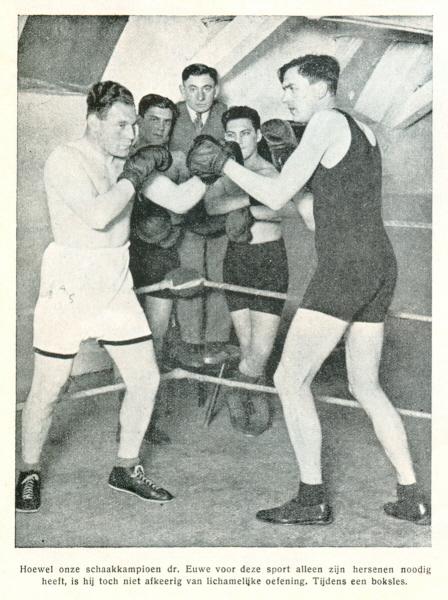
Other chess masters’ names also come to mind, but here we conclude with a brief item, quoting E.B. Osborn, from page 267 of the August 1919 BCM:

5571. Chess and wrestling (C.N. 2819)
C.N. 2819 (see page 71 of Chess Facts and Fables) referred to:
- Max Krauser (‘Heavyweight Wrestling Champion of Europe’);
- Kola Kwariani (‘a 250 pound New York wrestler who speaks eight languages and rates as the only chess playing-professional grappler in the country’);
- F.O. Egger (‘wrestling champion of Europe’).
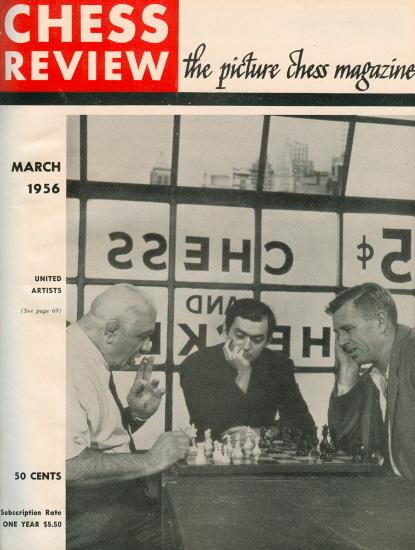
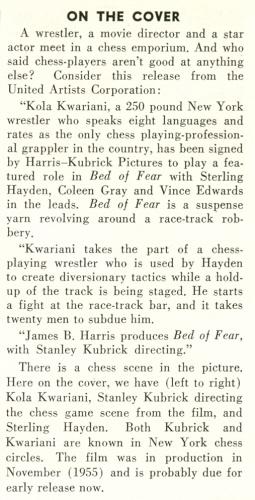
We add now that there are references to Kwariani (‘Kak-Kak’) on pages 24, 39 and 79 of Hooked on Chess by Bill Hook (Alkmaar, 2008).
5572. Nimzowitsch and exercise (C.N.s 5548 & 5552)
This is the work referred to by Nimzowitsch, as mentioned in C.N. 5552: Mein System 15 Minuten täglicher Arbeit für die Gesundheit by J.P. Müller (Copenhagen and Leipzig, 1904).
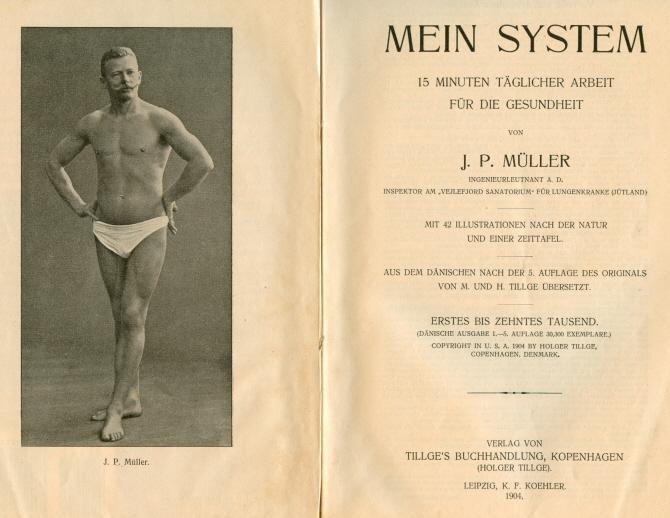
The book first appeared in Danish in August 1904, sold very well and was translated into various languages.
5573. Szén
From page 51 of Chess Characters by G.H. Diggle (Geneva, 1984) we quote part of the first paragraph, written in 1979:
‘A welcome phenomenon of chess literature, especially in the last decade, is the remarkable revival of the demand for strict historical accuracy almost equal to that which prevailed in the golden days of H.J.R. Murray, whose massive articles filled the BCM Volumes of the Edwardian era. Between the Wars, and for some time after, things had got very slack, and historical research amounted all too often to copying from the latest potboiler. For example, a well-known American author, writing in rhetorical style about the 1851 Tournament, referred to “swashbuckling Szén” – rather a misnomer, as Szén’s style was described by Mongrédien as “slow, heavy and tedious” though he was a fine endgame player. But sure enough, the next author to deal with this tournament did not fail to include in its participants “Joseph Szén, a swashbuckling player from Hungary”.’
Diggle refrained from naming names, and the best that we can do at present is to provide these quotes:
- ‘Josef Szen, the swashbuckling Hungarian, polishes off Newham in two straight games.’
Source: P.H. Little on page 13 of the January 1949 Chess Review. The article, on London, 1851, was reproduced in F. Reinfeld’s The Treasury of Chess Lore (New York, 1951). See page 93.
- ‘... Josef Szen, a swashbuckling Hungarian ...’
Source: The Chess Scene by D. Levy and S. Reuben (London, 1974), page 23.
Mongrédien’s opinion of Szén, from page 274 of the June 1888 BCM (an article entitled ‘Chessplayers I Have Known’):
‘With this sturdy Hungarian player I only had a few games during his short visit to London in 1851, and I came off second best. His style was about the slowest, the heaviest, and the most tedious that I ever came across, and the man himself was eccentric, ungenial and dreamy. His great power of abstraction, however, enabled him to concentrate all his attention on the game, and he was great at unravelling the knot of an intricate position.’
5574. Quiz question
Which chessplayer did Edgar Lustgarten describe as being ‘the subject of more public discussion than any other English clergyman since Wolsey’?
5575. Feline photographs
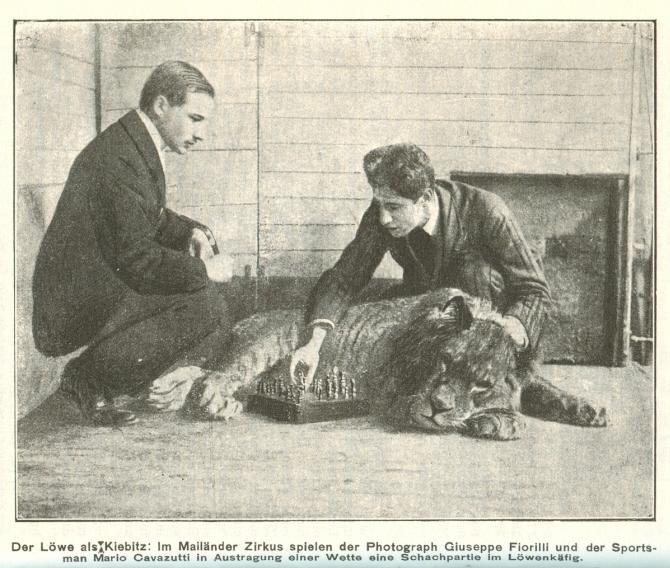
The above photograph of Giuseppe Fiorilli and Mario Cavazutti at the Milan circus was published on page 130 of the April-May 1910 Wiener Schachzeitung. The two pictures below come from pages 6 and 8 of Zooals ik het zag (Amsterdam, 1935 and 1976).
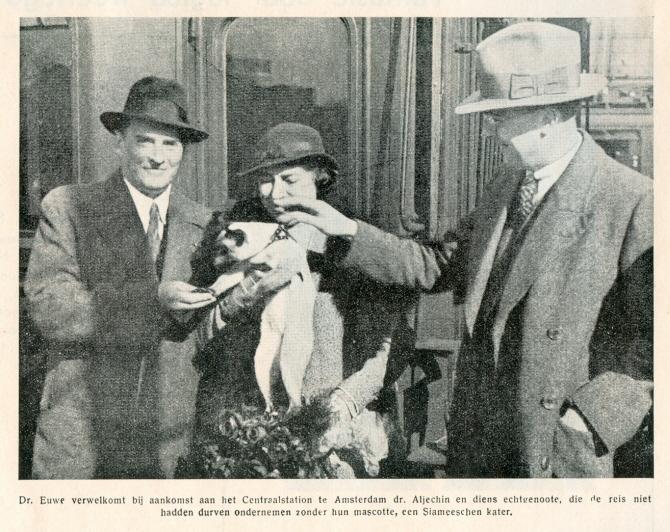

Finally, two photographs from opposite page 64 of Caïssas
Weltreich by Max Euwe and Bob Spaak
(Berlin-Frohnau, 1956):
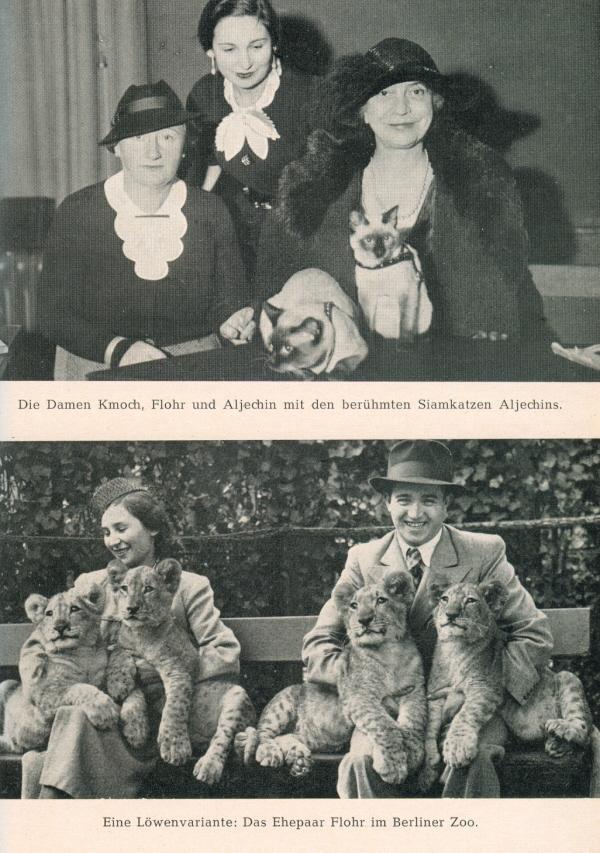
5576. Pillsbury’s death (C.N. 4948)
Scott D. Young (Crawfordville, FL, USA) reverts to a matter which he raised in C.N. 4948: ‘Who was the first to print the cause of Pillsbury’s demise?’ The question remains open, but our correspondent notes that Dale Brandreth (Yorklyn, DE, USA) was spontaneously informed by two people that Pillsbury died of syphilis: by Bill Ruth in a telephone conversation circa 1968 and, some two years later, by Walter Penn Shipley (the son of the well-known chess figure of the same name).
It may be recalled that Walter Korn attempted to put a timetable on Pillsbury’s alleged contraction of the disease at St Petersburg 1895-96; see pages 70-74 of his book America’s Chess Heritage (New York, 1978).

Hanover, 1902 (C.N. 4246)
Dr Brandreth also notes in this context that Pillsbury married in 1901 (see C.N. 4246). As mentioned in that item, we recall no references to Mary Ellen Bush after Pillsbury’s death in 1906. There is some hunting to be done regarding her later life.
5577. Bogoljubow sketch (C.N.s 3601 & 3623)
Javier Asturiano Molina (Murcia, Spain) notes that the sketch purportedly depicting Bogoljubow was the work of Enrique Segura and was published on page 240 of Ajedrez Español, August 1943:

The ‘Bogoljubof’ prompts us to wonder whether any master has had his surname spelt so many different ways. It should be possible to find at least 15 or 20 variants.
Addition on 9 January 2022:
Our Spanish correspondent notes ‘Boglojubov’ on page 245 of Emanuel Lasker The Life of a Chess Master by Jacques Hannak (London, 1959).
5578. H.B. Daly (C.N.s 1535 & 1606)
C.N. 1535 (see pages 67-68 of Chess Explorations) gave this game:
Milton Kagan – Harlow Bussey DalyBoylston v Bay State Match, 29 December 1939
Sicilian Defence
1 e4 c5 2 Nc3 Nc6 3 Nf3 g6 4 d4 cxd4 5 Nxd4 Bg7 6 Be3 d6 7 Bc4 a6 8 Nd5 e6 9 Nxc6 bxc6 10 Bb6 Qg5 11 Nc7+ Ke7 12 Nxa8 Qxg2 13 Rf1 Bxb2 14 Bd3 Bc3+ 15 Ke2 e5 16 Rg1 Bg4+ 17 Ke3 Bd4+ 18 Bxd4 exd4+ 19 Kf4 g5+ 20 Kxg5
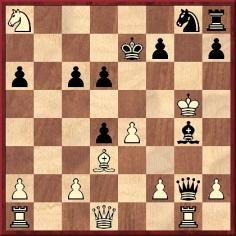
20...h6+ 21 Kf4 Qxh2+ 22 Kxg4 Nf6+ 23 Kf3 Qh5+ 24 Kg2 Rg8+ 25 Kf1 Qh3+ 26 Ke2 Qh5+ 27 Kd2 Qa5+ 28 c3 dxc3+ 29 Ke2 Qh5+ 30 f3 Qh2+ 31 Ke3 Rxg1 32 Qxg1 Qd2+ 33 Kd4
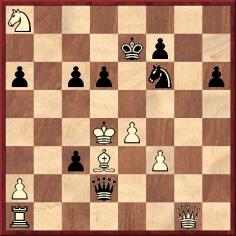
33...c5+ 34 Kc4 Nd7 35 f4 c2 36 Qe1 Qxf4 37 Bxc2 Ne5+ 38 Kb3 Nf3 39 Qc3 Nd4+ 40 Kb2 Nb5 41 Qg7 Qe3 42 Rf1 Qa3+ 43 Ka1 Resigns.
Source: page 26 of a booklet privately printed in 1975, 75 Years of Affection for Chess, A Tribute to Harlow B. Daly by Harry Lyman and Stephen Dann.
We quoted the heading to the game:
‘An unbelievable classic. John Curdo found a marvelous win for Harlow. Can you?’
In C.N. 1606 the late Harry Lyman reported that he had consulted Kagan’s original game notebooks, which contained a recommendation by Daly of 20...Qh3. Lyman added:
‘Without consulting Curdo, I seem to remember that his solution is also based upon 20...Qh3!’
Even today, two decades on, we are caution personified in the use of computer analysis, and the question is therefore thrown open to readers: did Black miss a (clear) win?
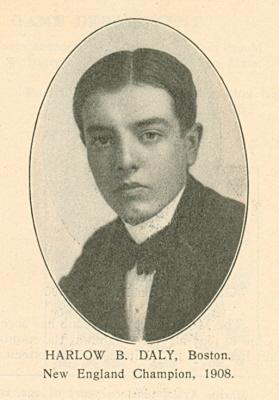
American Chess Bulletin, February 1909, page 41
5579. Famous quotation
Mark McCullagh (Belfast, Northern Ireland) proposes an addition to our feature article The Most Famous Chess Quotations:
‘A great chess-player is not a great man, for he leaves the world as he found it. No act terminating in itself constitutes greatness. This will apply to all displays of power or trials of skill, which are confined to the momentary, individual effort, and construct no permanent image or trophy of themselves without them.’
Source: Table-Talk by William Hazlitt (London, 1821), page 198.
This happens to be one of two chess quotes in the current edition of The Yale Book of Quotations by Fred R. Shapiro (C.N. 5520), the other being Tarrasch’s ‘power to make men happy’ remark.
5580. Zukertort odds game
From Olimpiu G. Urcan (Singapore):
‘Manolache Costache Epureanu (1823-80) was a Romanian politician who held important government posts between 1870 and 1876 and was an influential leader of the Romanian Conservative Party. He was born in Moldavia, in a family with prestigious medieval roots, and he studied at Göttingen, Berlin and Jena before returning to Romania in 1843. Epureanu took part in the Romanian Revolution of 1848 and fought for its libertarian ideals. In the political turmoil of that time he was one of the strongest defenders of the Unionist cause (the union of Moldavia with Wallachia). He was a close friend of Alexandru Ion Cuza, the elected Prince of Moldavia and Wallachia. For short periods between 1860 and 1880 he served as Prime Minister, Minister of Justice and President of the Conservative Party. His interest in chess is shown by these three matters:
a) His assistance to Adolf Albin to publish his primer in Romanian Amiculǔ’ Joculǔ’ de Schach. Theoreticu şi Practicǔ (Bucharest, 1872). On the front cover Albin made it evident that there was a special relationship between them, as he dedicated his work to Epureanu.
b) His being the subject of Şah şi Mat, a literary sketch written in 1898 by Ion Luca Caragiale, a playwright and a critic of Romanian bourgeois society.
c) His now-famous loss to Zukertort, the background to which was presented on pages 228-230 of Arcymistrz z Lublina by C.W. Domański and T. Lissowski (Warsaw, 2002).’
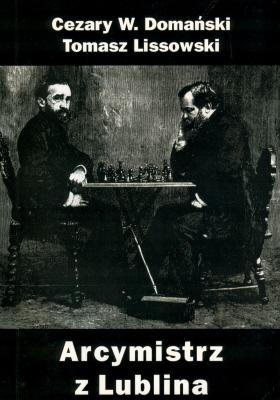
We are also grateful to Tomasz Lissowski (Warsaw) for providing a summary of that book’s coverage of Zukertort v Epureanu, which includes an account of the difficulties initially experienced by chess writers in establishing the game’s authenticity, let alone circumstances, until it was found that Blackburne had annotated it on page 68 of the April 1874 City of London Chess Magazine. A footnote on page 230 of Arcymistrz z Lublina mentions that unfortunately no source was given on page 212 of Jimmy Adams’ book on Zukertort for the statement that the game was played in May 1872. However, the Polish co-authors find 1872 a perfectly plausible date, since at that time Zukertort was a celebrity in Berlin who could well have had occasion to play against an eminent guest from Romania.
5581. Nimzowitsch and exercise (C.N.s 5548, 5552 & 5572)
Tim Bogan (Chicago, IL, USA) quotes from page 5 of Achieving the Aim by Mikhail Botvinnik (Oxford, 1981):
‘I was a round-shouldered lad with a flat chest and didn’t go in for sport. Mother introduced me to a tall well-built young lady, probably one of her patients (Mother was a dentist). As a present I was given a book by Muller which was well known in those days. I tried to live according to Muller, and quite liked it. For the half-century or so since then I have done morning exercises. The weak lad straightened up and, as they say nowadays, noticeably “filled out”.’
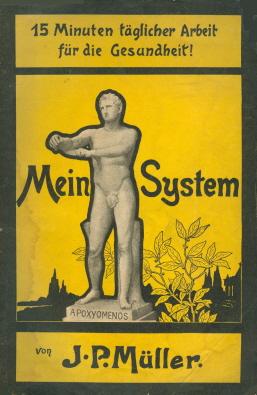
Front cover of the first German edition of J.P. Müller’s book
5582. Bird v Anderssen
Eduardo Bauzá Mercére (New York, NY, USA) refers to this victory by Anderssen over Bird:
1 e4 e5 2 Nf3 Nc6 3 Bb5 Nf6 4 d4 exd4 5 O-O Be7 6 Re1 O-O 7 e5 Ne8 8 Nxd4 Nxd4 9 Qxd4 d5 10 Nc3 c6 11 Bd3 Be6 12 Qf4 f5 13 exf6 Rxf6 14 Qg3 Bd6 15 Qh4 h6 16 Be3 Qc7 17 Ne2 g5 18 Qa4 b5 19 Qd4 c5 20 Qc3 c4 21 Bd4
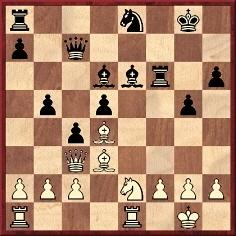
21...b4 22 Qd2 cxd3 23 Bxf6 Nxf6 24 Nd4 Bd7 25 Qxd3 Kh8 26 Qg6 Bxh2+ 27 Kf1 Qc4+ 28 Qd3 Rf8 29 Qxc4 dxc4 30 Re7 Bd6 31 Re2 Ng4 32 Rd1 Bc5 33 c3 Rf4 34 f3 Bxd4 35 cxd4 Bb5 36 Ke1 Nf6 37 Re5 Ba4 38 b3 cxb3 39 axb3 Bxb3 40 Rb1 Bd5 41 Rxb4 Kg7 42 Re7+ Kg6 43 Rxa7 h5 44 Ra6 h4 45 Rbb6
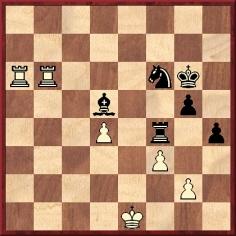
45...g4 46 Kf2 h3 47 Kg3 Kg5 48 Rxf6 Rxf6 49 Ra5 Rf5 50 f4+ Kg6 51 gxh3 gxh3 52 Rb5 Be6 53 Re5 Bd7 54 Re3 Rd5 55 Rd3 Kf5 56 Kf3 Bc6 57 Kg3 Ke4 58 Rd1 Bd7 59 Re1+ Kxd4 60 Re7 Kc3 61 Re2 Rd2 62 Re5 Rg2+ 63 Kf3 Bc6+ 64 Ke3 h2 and wins.
Our correspondent notes that a number of books – the Wildhagen and Pickard monographs on Anderssen (pages 92 and 208 respectively) and Levy and O’Connell’s Oxford Encyclopedia of Chess Games (page 362) – state that the game was played in London in 1862, whereas the correct date is 14 July 1866. Taken from the Illustrated London News, it was published on pages 176-178 of volume II of Chess World (dated 1867, but covering 1866) with the following introduction:
‘The famous German master Anderssen arrived in London on 14 July, for the purpose of playing the match which has been arranged between him and Mr Steinitz. Although somewhat fatigued by a long journey, Mr Anderssen, with characteristic gallantry, on visiting the Grand Cigar Divan that afternoon, accepted the invitation of Mr Bird to a friendly passage d’armes, and the result was the very instructive game which follows.’
We wonder who first suggested that the game had been played in 1862. Its placing on pages 228-229 of Adolf Anderssen by Hermann von Gottschall (Leipzig, 1912) certainly gave that impression.
5583. Who? (C.N. 5566)

This photograph of Gordon Thomas Crown was published in a feature about him on pages 176-177 of CHESS, March 1947. Four of his games were given, including the readily-available wins over P. Morley (‘Friendly game in January 1945’) and S. Lipton (no occasion specified). Regarding the Morley encounter, Crown commented:
‘Although this is only a friendly game, I give it because it is the only “short brilliancy” I possess in which my opponent has not made any bad mistake.’
He described his win over Lipton as ‘Undoubtedly my best all-out attacking game in serious play.’
On 17 November 1947 Crown died when his diabetes caused complications during an operation. He was 18.
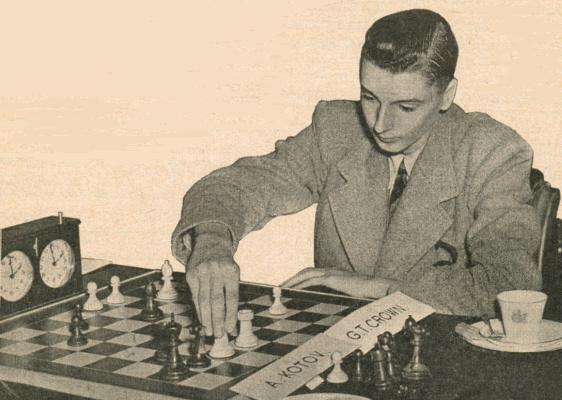
The final position of his most famous game (CHESS, January 1948, page 86)
5584. Gordon Crown
Two further snippets are provided on Gordon Crown, the first being a brief feature about the Richter Attack on page 174 of the August 1944 BCM:

The shortest game involving Crown that we have found was on page 141 of the May 1946 BCM:
J.A. Fuller – Gordon Thomas CrownBritish Boys’ Championship, Hastings, April 1946
Ruy López
1 e4 e5 2 Nf3 Nc6 3 Bb5 a6 4 Ba4 Nf6 5 O-O Nxe4 6 Re1 Nc5 7 Nc3 Nxa4 8 Nxe5 Ne7 9 Qf3 Resigns.
The game was published unobtrusively by the BCM but received a large page to itself (page 205) in The Chess Apprentice by R. Bott and S. Morrison (London and Glasgow, 1960).
5585. Rook endgames (C.N. 5498)
From Ola Winfridsson (Cambridge, England):
‘I have found a passage that may shed some further light on the saying “All rook endgames are drawn”, although without nailing the quote as such. In the Göteborg, 1920 tournament book Rubinstein’s notes to the game A. Selesniev v S. Tartakower from round six of tournament A (the grandmaster group) included the following statement in a comprehensive comment on 29...Rc8 (see page 60):
“... Den av svart valda fortsättningen ser bra ut och leder till bondevinst, men därefter återstår blott remisfigurerna, tornen, då en bonde mer sällan räcker till vinst ...” [“... The continuation chosen by Black looks convincing and leads to the win of a pawn. However, this leaves only the drawing pieces, the rooks, when an extra pawn is seldom enough to win ...”]This would seem to indicate that it was a generally accepted piece of chess wisdom among the leading grandmasters (Tarrasch, Tartakower and now Rubinstein) at the time that rook endings were notoriously drawish in character.’
5586. H.B. Daly (C.N.s 1535, 1606 & 5578)

Black to move
From Lonnie Kwartler (Chester, NY, USA):
‘In the game Kagan-Daly, Daly’s suggestion of 20...Qh3 wins. The point is that either 21 Qxg4 or 21 Rxg4 is answered by 21...Qh6+ 22 Kf5 Qf6 mate. This means that Black’s queen and bishop are safe, while White’s queen and king are in danger.
If 21 Kf4 Bxd1. If 21 f3 Bxf3 22 Qxf3 (22 Kf4 Bxd1 or 22 Rg3 Qh6+ 23 Kf5 Qf6 mate) 22...Qxf3 23 Raf1 Qe3+ 24 Kh4 Nf6 25 Nb6 Qh6+ 26 Kg3 Rg8+ 27 Kf3 Qh5+. If 21 Rg3 Qh5+ 22 Kf4 Bxd1. If 21 Qf1 Qh5+ 22 Kf4 Nf6 23 Rxg4 (23 f3 Qe5 mate) 23...Qxg4 mate.’
5587. Capablanca book
Yakov Zusmanovich (Pleasanton, CA, USA) asks for information about the Capablanca book being held by Lenier Domínguez Pérez and other players in a ChessBase report on the 2008 Capablanca Memorial tournament in Havana.
We are grateful to Frederic Friedel (Hamburg, Germany) for a more detailed photograph:
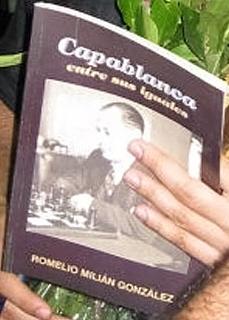
The book, by Romelio Milián González, appears to be entitled Capablanca entre sus iguales. Information on how to obtain it will be appreciated.
5588. C.G. Bennett
Norman Blake (London) notes a report about his great-uncle, Charles George Bennett, on page 228 of the May 1926 BCM:
‘The late C.G. Bennett, who died recently at Gravesend, has left his valuable chess library to his old club at Harrogate. In addition he has bequeathed a fund to provide a Bennett memorial prize for annual competition by members of the club under 21 years of age.’
It may be wondered whether many old examples exist of memorial prizes to encourage young players.
The game that follows was annotated by Edward Freeborough on pages 243-244 of the June 1886 BCM:
Charles George Bennett – T.Y. StokoeHuddersfield, 17 April 1886
Irregular Opening
1 Nc3 d5 2 d4 Nc6 3 e3 e6 4 a3 Nge7 5 Nf3 Ng6 6 Bd3 Bd6 7 e4 Nf4 8 e5 Nxd3+ 9 Qxd3 Be7 10 Be3 a6 11 Ne2 Bd7 12 Ng3 O-O 13 h4 f5 14 exf6 Bxf6 15 Ng5 Bxg5 16 hxg5 g6 17 f4 Ne7 18 O-O-O Nf5 19 Bd2 Bb5 20 Qc3 b6 21 Rde1 Qd7 22 Ne2 c5 23 g4 cxd4 24 Nxd4 Rac8

25 Nxf5 Rxc3 26 Nh6+ Kg7 27 Bxc3+ d4 28 Bd2 Rc8 29 f5 exf5 30 gxf5 gxf5 31 Re7+ Qxe7 32 Nxf5+ Kf8 33 Bb4 Qxb4 34 axb4 Bd3 35 Nxd4 Bg6 36 Rf1+ Ke8 37 Rf6 Rb8 38 Ne6 Rb7 39 Nf4 Bf7 40 b3 Ke7 41 Kb2 Be8 42 c4 Bf7 43 Kc3 Ke8 44 Nd3 Bg6 45 Ne5 Bb1 46 Re6+ Kd8 47 Rd6+ Kc8 48 c5 bxc5 49 bxc5 Ba2 50 b4 a5 51 bxa5 Rb5 52 Rc6+ Kd8 53 a6 Ke7 54 a7 Ra5 55 Kb4 Rxa7 56 Rh6 Kf8 57 Kb5 Rg7 58 c6 Ke8 59 Kc5 Kd8 60 Kd6 Bf7 61 Rf6 Be8 62 Rf8 Re7 63 Nd7 Re1 64 c7+ Kc8 65 Nb6+ Kb7 66 c8(Q)+ Resigns.
5589. Spielmann’s complaint
C.N. 1539 (see pages 68-69 of Chess Explorations) quoted Rudolf Spielmann from page 18 of Torneo internacional de ajedrez Dortmund 1928 (Martínez, 1967):
‘I am bound to believe that it is only against me that opponents display their full strength.’
The context was that in the third round he was defeated by Bogoljubow, who lost recklessly to van Nüss in round four.
Page 117 of The Chess Masters on Winning Chess by Fred Reinfeld (New York, 1960) suggested that this was a frequent complaint by Spielmann:
‘Away from the chessboard he was a timid and modest man, always plaintively wondering out loud why every opponent played his best chess against him.’
Wanted: other instances of the grievance being expressed by Spielmann.

Rudolf Spielmann
5590. Chess in India
Marc Hébert (Charny, Canada) asks for information about one of John Cochrane’s Indian opponents who is featured in databases, Mahescandra. We take this to be a variant of Moheschunder (or Mohishunder), and advice will be welcomed on the rights and wrongs, if any, of these spellings.
The following appeared on pages 68-69 of A Century of British Chess by P.W. Sergeant (London, 1934):
‘Cochrane had gone back to India, and in 1848 we hear of him, as president of the Calcutta Chess Club (in the foundation of which he was largely instrumental), still seeking for opponents out East capable of testing the skill which he had so worthily proved in the West. One was at last found. A member of the club in the autumn of 1848 heard of a Brahman in the Mofussil – up country, as we might say – who had never been beaten at chess. He found an opportunity of meeting him, played him, and lost. It was stated that the man, “Moheschunder Bonnerjee, a Brahmin”, of about 50, hardly knew the European rules of chess; yet his play was presumably under European rules.
Delighted with his find, the Calcutta member took him back with him, and passed him on to Cochrane as an opponent. Cochrane beat him, but was sufficiently impressed with his skill to have him engaged as “a paid attaché” of the Chess Club, where he improved wonderfully. In the [Chess Player’s Chronicle] for 1851 are published some games between Cochrane and Moheschunder; and “the Brahmin” figures as a player in various collections of games. The Indian Defences by P-KKt3 coupled with P-Q3, or P-QKt3 coupled with P-K3, were largely taught to European players by the example of Moheschunder and other Indians, to whom the fianchetto developments were a natural legacy from their own game. The fondness for them of the present Indian champion of British chess, Mir Sultan Khan, is well known. But they are now so widely popular that Dr S.G. Tartakower was able to declare, some years ago, that “today fianchettos are trumps”. A sequel hardly to have been anticipated from the discovery of Moheschunder in the Mofussil.’
Sergeant’s information was largely based on a letter from a member of the Calcutta Chess Club on pages 318-319 of the 1850 Chess Player’s Chronicle, which included the following:
‘The only player here who has any chance whatever with Mr Cochrane, upon even terms, is a Brahmin of the name of Moheschunder Bonnerjee. Of this worthy, Mr Cochrane has himself remarked that he possesses as great a natural talent for chess as any player he ever met with, without one single exception.’
Some nineteenth-century references to ‘Indian’ in connection with openings, including a mention of Moheschunder, are given in the feature article Earliest Occurrences of Chess Terms.
The game below, from pages 154-155 of the 1854 Chess Player’s Chronicle, is an example of Cochrane’s attacking zeal:
John Cochrane – MoheschunderIndia, circa 1854
Irregular Opening
1 e4 d6 2 d4 Nf6 3 Nc3 e6 4 f4 Be7 5 Nf3 O-O 6 Be2 b6 7 O-O c5 8 dxc5 bxc5 9 Bd3 Nbd7 10 e5 dxe5 11 fxe5 Nd5 12 Ne4 Qc7 13 Nfg5 Nxe5 14 Nxh7 Nxd3 15 cxd3 Kxh7 16 Qh5+ Kg8 17 Rf3 e5 18 Rg3 f5
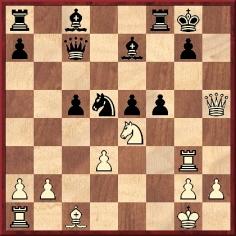
19 Rxg7+ Kxg7 20 Bh6+ Kh8 21 Bxf8+ Kg8 22 Bh6 Nf4 23 Qe8+ Kh7 24 Bxf4 fxe4 25 Qf7+ Kh8 26 Bg5 Bd8 27 Bf6+ Resigns.
Page 141 of Kings, Commoners and Knaves gave another win by Cochrane against the same opponent, contributed by Jack O’Keefe. He described it as ‘one of the most remarkable Grünfelds ever played’, given that it occurred not just before Grünfeld’s career but even before Morphy’s:
1 d4 Nf6 2 c4 g6 3 Nc3 d5 4 e3 Bg7 5 Nf3 O-O 6 cxd5 Nxd5 7 Be2 Nxc3 8 bxc3 c5 9 O-O cxd4 10 cxd4 Nc6 11 Bb2 Bg4 12 Rc1 Rc8 13 Ba3 Qa5 14 Qb3 Rfe8 15 Rc5 Qb6 16 Rb5 Qd8 17 Ng5 Bxe2 18 Nxf7 Na5 and White mates in three.
To quote the remainder of our earlier item:
‘According to the Chicago Tribune of 13 July 1879, which took the score from the Glasgow Herald, the game was played between Cochrane and Moheschunder in May 1855. It was also annotated by Steinitz in The Field of 6 June 1874 [page 565].’
This sketch of Cochrane by Samuel Loyd, based on a picture in the Westminster Papers, was published on page 1964 of the Scientific American Supplement, 11 May 1878:

5591. Корчной
Our remark in C.N. 5577 about the different ways in which Bogoljubow’s name is spelt has prompted Javier Asturiano Molina (Murcia, Spain) to report on another case:
‘I have found Korchnoi, Kortchnoi, Kortschnoi, Kortsnoi, Kortshnoi, Korchnoï, Kortchnoï, Korchnoy, Kortchnoy, Kortschnoy, Korchnoj, Kortchnoj, Kortschnoj, Korcznoj, Korcsnoj, Kortjnoj, Kortsjnoj, Kortšnoi and Korčnoj.’
5592. Quiz question (C.N. 5574)
C.N. 5574 asked which chessplayer Edgar Lustgarten described as being ‘the subject of more public discussion than any other English clergyman since Wolsey’.
The observation appeared on page 290 of Lustgarten’s book The Judges and The Judged (London, 1961), in his chapter on ‘The Rector of Stiffkey’, Rev. Harold Francis Davidson (1875-1937). Davidson’s ‘extra-rectorial activities’, to borrow the genteelism coined by Lustgarten, have been widely narrated. One of the lesser-known monographs is The Rector of Stiffkey and Morston by Buttercup Joe (Briston, 1985 and 1987):
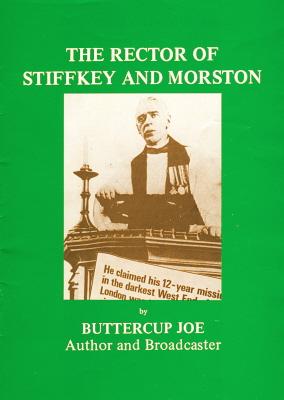
Davidson’s death was briefly mentioned on page 7 of CHESS, 14 September 1937:

In fact, Davidson survived the mauling for two days, and the circumstances of his death, in hospital, appear quite complex. Of course, that is too dull for a book such as The Even More Complete Chess Addict by M. Fox and R. James (London, 1993), and so page 22 had some ‘fun’ by making out that the lion devoured Davidson.
At the beginning of the century Davidson represented Oxford University on several occasions, and two of his games are given here:
Harold Francis Davidson (Oxford University) – F.W. Clarke (Cambridge University)London, 21 March 1902
Scotch Game
1 e4 e5 2 Nf3 Nc6 3 d4 exd4 4 Nxd4 Nf6 5 Bg5 h6 6 Bh4 g5 7 Nxc6 dxc6 8 Qxd8+ Kxd8 9 e5 Ng4 10 Bg3 Bg7 11 Nc3 Nxe5 12 O-O-O+ Bd7 13 Rd2 Kc8 14 Be2 Be6 15 Rhd1 b5 16 a3 a5 17 Ne4 Bd5 18 Bxe5 Bxe5 19 Bg4+ Kb8 20 Re2 Bf4+ 21 Kb1 Ka7 22 g3 Be5 23 Nc5 Bd6 24 Nb3 h5 25 Bf5 Bf3 26 Rde1 Bxe2 27 Rxe2 Kb6 28 Nd4 Rae8 29 Rd2 Re7 30 f3 c5 31 Ne2 Rhe8 32 Nc3 Re1+ 33 Ka2
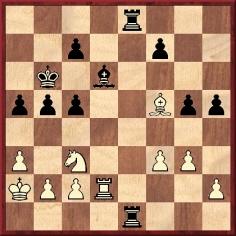
33...b4 34 axb4 axb4 35 Nd5+ Kb7 36 Nf6 R8e2 37 Be4+ Kb8 38 Rd5 c6 39 Rxd6 Rxh2 40 Rxc6 Ree2 41 Rxc5 h4 42 Nd7+ Ka7 43 Ra5 mate.
Source: The Field, 29 March 1902.
From page 197 of the April 1902 BCM:
J.F. Sawin (Yale University) – Harold Francis Davidson (Oxford University)‘At 5 o’clock the score stood Cambridge 3½, Oxford 2½, with the unfinished game distinctly in favour of the Cantab., who was the exchange and a pawn ahead. Mr Clarke, however, made a slip and left a piece en prise, and so enabled Mr Davidson to announce mate in two, bringing the score to Cambridge 3½, Oxford 3½, and drawing the match.’
Cable match, 27 March 1903
Ruy López
1 e4 e5 2 Nf3 Nc6 3 Bb5 a6 4 Ba4 Bc5 5 O-O Nf6 6 c3 b5 7 Bc2 d5 8 d4 exd4 9 e5 Ne4 10 cxd4 Bb6 11 Re1 Bf5 12 Nc3 Nb4 13 Bxe4 dxe4 14 Nxe4 Qd5 15 Qe2 Rd8

16 Nf6+ gxf6 17 exf6+ Be6 18 Ng5 Rg8 19 Qg4 Kd7 20 Qf4 Nd3 21 White resigns.
Source: The Field, 4 April 1903.
5593. Who?
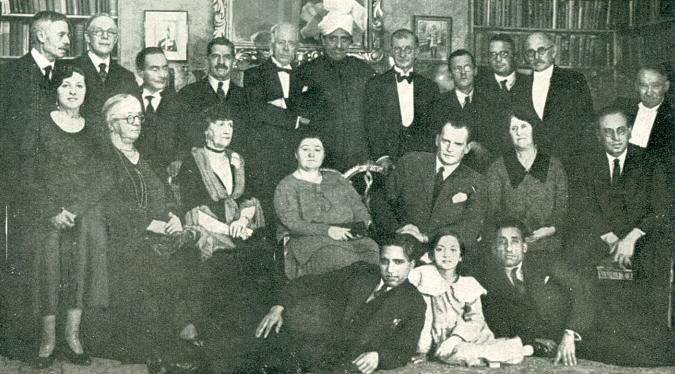
5594. Back-rank mate
Information is still being sought about this game, discussed on pages 65-66 of A Chess Omnibus:
1 e4 e5 2 f4 exf4 3 Nf3 g5 4 Bc4 g4 5 Bxf7+ Kxf7 6 Ne5+ Ke6 7 Qxg4+ Kxe5 8 d4+ Kxd4 9 b4 Bxb4+ 10 c3+ Bxc3+ 11 Nxc3 Kxc3 12 Bb2+ Kxb2 13 Qe2+ Kxa1

14 Kf2 mate.
Page 120 of Robert Timmer’s Startling Castling! (London, 1997) stated that White played 14 O-O mate. That book gave White’s name as F.C. Spencer, with no other details. When the game appeared on page 159 of the May 1894 Deutsche Schachzeitung White was identified as J. Spenser of Minnesota. Giving the score (also with 14 Kf2) on page 200 of its July 1917 issue, the BCM offered no players’ names or occasion, but the score was said to be derived from the Illustrated Sporting and Dramatic News of 1894. It appeared in the 1895 book Chess Sparks by J.H. Ellis, headed only ‘Played at Mineapolis [sic] Chess Club, about 1894’.
5595. Adams victory
Alfonso Ansó Rojo (Saragossa, Spain) enquires about a short game (Albin Counter-Gambit) given on pages 58-60 of volume one of Ajedrez hipermoderno (Madrid, 1945), a book published ‘under the direction’ of Alekhine. (In the re-issue of the book, the relevant pages are 39-40.) The game is headed Smith v W. Adams, with no other details except that it was played in the United States. However, our correspondent notes that databases give the game as having occurred between Marchand and W. Adams.
We can say that the score appeared on page 149 of the August-September 1941 Chess Review:
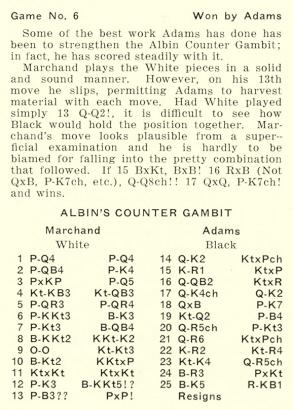
White was Erich Marchand, and Black was Weaver W. Adams. The game was played in the Annual Open Tournament of the United States Chess Federation in Saint Louis, MO in July 1941. How White came to be identified as ‘Smith’ is currently unclear.
5596. Berlin, 1927 (C.N. 5500)
Dominique Thimognier (St Cyr sur Loire, France) draws attention to a webpage of the Berliner Schachverband which reproduces the coverage of Berlin, 1927 in Frei Schach!, November 1928.
[Addition on 14 October 2015: the above link no longer works.]
5597. Self-contradictions
Our Factfinder has an entry on self-contradictions, and below we reproduce two pairs from Reuben Fine, as given in C.N. 1424.
On page 37 of the November 1953 CHESS Irving Chernev pointed out these statements by Fine:
- Chess Review, February 1941, page 32: ‘As a matter of fact, Alekhine has tried to emphasize the psychological element far more than Lasker ever did, but without any success as far as I can see ...’
- Chess Review, April 1946, page 19: ‘Alekhine, not Lasker, was the outstanding exponent of psychology in chess.’
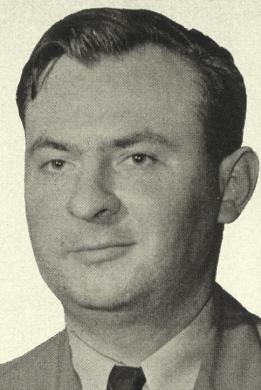
Reuben Fine
The other example was shown by us on page 10 of CHESS, October 1976:
- The World’s Great Chess Games (page 112): ‘As far as style goes, there were three Capablancas. The first was the boy who, like every aspiring youngster, thought of brilliancies, attack at all cost.’
- The Psychology of the Chess Player (page 51): ‘He never seems to have gone through the romantic attack-at-all-costs period which so many young players go through.’
| First column | << previous | Archives [46] | next >> | Current column |
Copyright: Edward Winter. All rights reserved.
